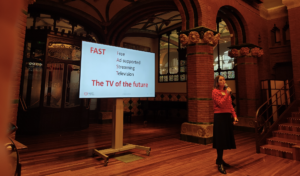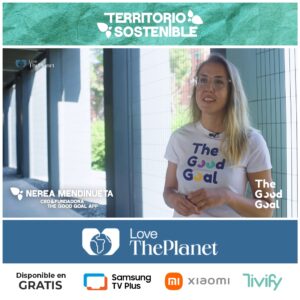
After more than 40 years of operation, DTVE is closing its doors and our website will no longer be updated daily. Thank you for all of your support.
How to succeed in FAST: lessons from Love TV Channels

Teresa López celebrates Love TV Channels’ first anniversary
Free advertising-supported streaming television (FAST) has grown dramatically over the last couple of years – a trend that was fuelled by a mix of post-COVID subscription fatigue, a drive on the part of rightsholders to tap into new revenue streams and maximise the value of their property, and a sense of the potential of addressable advertising to increase the value of inventory.
However, FAST is not a straightforward venture in which success is all but guaranteed. The challenges to making a sustainable business from it are considerable, and there is an expectation that many who venture into the FAST world will not turn a profit.
Experience, making the right connections, and an ability to assess the proposition thoroughly are vital. All of those are qualities held by the management team of Spain’s Love TV Channels, a pure FAST venture that this week announced that it has passed the milestone of launching 13 FAST channels in 17 countries.
With over five million monthly active users, the channel provider is looking to expand its business in 2024, with a new investment round in the works from which the company’s owners aim to raise €5 million. (Love TV Channels previously received €1 million in funding from the European media Programme).
The funds from the new investment round will be allocated towards launching new channels (of which more below), creating original content, and developing an AI tool to optimize content acquisition decisions.
Focus on European market

Love TV Channels focuses on well-defined thematics, including sustainability
Love TV Channels is focused squarely on the European market, where growth of FAST is expected to be significant, from a lower base than the already large US market.
“Europe has the challenge of different languages and different cultures, so you need to have all these in consideration when you are producing localised channels and you want to engage with the local audience,” admits co-founder and CEO Teresa López, interviewed by recently by DTVE with the company’s other co-founder, Jacinto Roca.
Roca, previously CEO of Rakuten TV Europe and co-founder of Wuaki.tv, adds that the very fragmented nature of the market means that those with local knowledge and expertise have an advantage.
“The opportunity is precisely the fact that since Europe is so fragmented a market, American players normally struggle with that, and that is the competitive advantage we have: being European and understanding the particularities of each one of the markets and having local teams in each one of the markets,” he says.
One other key difference between the US and Europe is that, while in the US FAST has emerged as an alternative to basic cable pay TV and has benefited from accelerating cord-cutting, in Europe the free TV universe is formidably strong, with relatively well-funded public broadcasters and still-strong commercial players capturing a large share of the available audience.
However, says López, most of these free players are generalist channels. Love TV Channels has taken the approach of building niche-interest channels that can capture an engaged audience around a particular genre or theme.
“If you talk about movies or TV series, there are plenty of free-to-air services, but if you are talking about wine or sustainability, those are the types of thing you don’t have channels for,” she says.
Content for the most part is in the form of acquisitions, but Love TV Channels is also looking to differentiate its offering by strategic forays into original programming, albeit on a small scale. López says the approach is to look for local personalities or influencers who can front programmes, for example about film festivals and movie premiers, or about sustainability for Love the Planet.
Channel schedules are therefore curated – albeit based on data – rather than programmed by algorithm. “You need to have local people to programme the channel, with relevant content based around events in that local market,” says López.
Discoverability and other challenges
While the characteristics of the still-small European FAST market may provide opportunities, FAST channel providers in general do share some common challenges, including the problem of discoverability – how to make your channel visible to viewers above the noise created by huge numbers of providers.
López says that Love TV Channels’ approach here is to work closely with distributor partners, highlighting content that could, for example, be promoted on the Samsung TV Plus UI. It also seeks to tie in with events, for example by creating special programming to link in with World Wildlife Conservation Day.
In addition to visibility within the UI of FAST operators, a related challenge is the current state of customer adoption of FAST in Europe, which remains low. “We still need time for people to discovery these channels and start viewing them,” says Roca. “It’s something of a chicken-and-egg problem. If you don’t have customers you can’t invest in content, but if you don’t invest in content, you won’t have customers. I think we need to invest over the next two to three years in building high-quality locally relevant channels.”
That focus on thematic interest groups feeds into Love TV Channels’ proposition for advertisers, and is key to the ‘targeting’ opportunity for advertisers associated with the rise of FAST and ad-supported streaming in general.
“Our channels are thematic and therefore the audience is already very segmented,” says López, pointing to communities of interest drawn to channels such as Love the Planet and Love Wine.
That focus on content-based segmentation feeds into Love TV Channel’s investment in original content, which López sees as being of considerable sponsorship interest.
Roca adds that branded content will play a key part in the mix, with a combination of “contextual targeting and branded content” offering a compelling proposition for advertisers.
While content-based segmentation and branded content are key elements of the proposition, Roca is clear that addressability is central to the case for ad-supported streaming.
“On traditional TV you don’t have the possibility to target based on customer data and even less the possibility of measuring the impact. Those are the two key benefits that FAST brings to advertisers,” he says.
Love TV Channels has until recently relied on programmatic ad sales, and partnered with RTL AdAlliance earlier this year to sell its inventory. López says that programmatic sales have been delivering good CPMs for the company – between €12 and €20 depending on the market – and revenues have been growing. More recently, the company decided to complement this with direct sales, related to its drive to develop branded content.
“This is very recent, but we have managed to close some deals. What we are proposing is all about special projects – the branded content or sponsored content that we are producing,” she says. “We are working very closely with the brands to understand exactly what they want to communicate.”
With little growth currently visible in the total advertising pie, Roca and López are convinced that growth for FAST will come from advertising spend migrating away from traditional linear channels to streaming, where the ability to target niche audiences and provide enhanced addressability and measurability of campaigns will be a crucial differentiator.
Future plans
On the question of one of the other challenges that independent FAST providers have faced recently – competition in content from the FAST platforms themselves – López says that Love TV Channels has the advantage of expertise in developing local content – something that is not necessarily easy to replicate.
“It is true that distributors could start producing their own channels, but the reality is that producing channels in each territory is not easy. We are dedicated to this, and we have the experience in-house,” she says.
Love TV Channels is therefore now embarking on the next phase of its growth, with plans in place for the launch of a new Crime and History channel in France this month, to be followed by the rest of Europe in the first quarter of next year. Love TV Channels also plans to launch a channel dedicated to European movies, with a very specific remit, and another focused on news. For the latter, the company is building partnerships with a range of publishers, enabling it to aggregate general and business news, weather and sports news from different sources into the channel.
Other plans include the conversion of the existing Love Wine channel into Love Wine and Travel, expanding its target audience, and the development of more original content for Love the Planet. The company is also working on extending its distribution, for example with launches on Pluto TV and Roku in the Latin American and US Spanish-language markets scheduled for next year.
Finally, Love TV Channels is also working on the development of an artificial intelligence-based tool that will take the viewership data the company generates on its channels and analyses it to better inform decision on content licensing, programming and investment in original content.
“Now is the moment for us to invest, because the audience for FAST is not there yet in Europe,” says Roca. “We need to invest in producing quality, locally relevant content. And then when the audience starts shifting to FAST, the value we will have created will be massive.”


